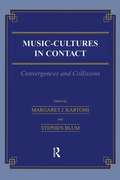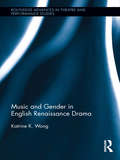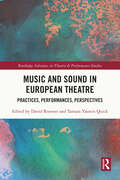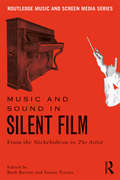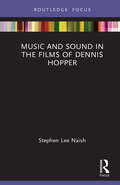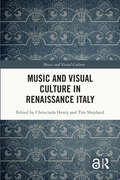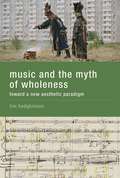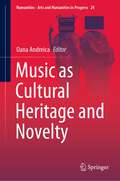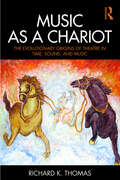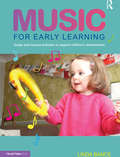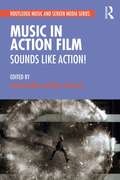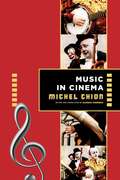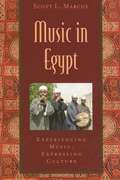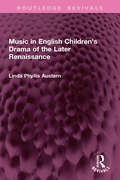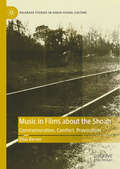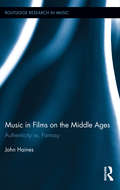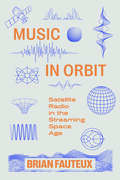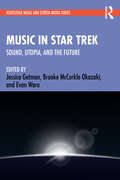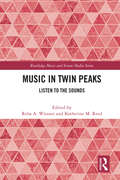- Table View
- List View
Music \= Cultures in Contact: Convergences and Collisions (Musicology #16)
by Margaret J. Kartomi Stephen BlumFirst Published in 1995. Routledge is an imprint of Taylor & Francis, an informa company.
Music and Gender in English Renaissance Drama (Routledge Advances in Theatre & Performance Studies)
by Katrine K. WongThis book offers a survey of how female and male characters in English Renaissance theatre participated and interacted in musical activities, both inside and outside the contemporary societal decorum. Wong’s analysis broadens our understanding of the general theatrical representation of music, or musical dramaturgy, and complicates the current discussion of musical portrayal and construction of gender during this period. Wong discusses dramaturgical meanings of music and its association with gender, love, and erotomania in Renaissance plays. The negotiation between the dichotomous qualities of the heavenly and the demonic finds extensive application in recent studies of music in early modern English plays. However, while ideological dualities identified in music in traditional Renaissance thinking may seem unequivocal, various musical representations of characters and situations in early modern drama would prove otherwise. Wong, building upon the conventional model of binarism, explores how playwrights created their musical characters and scenarios according to the received cultural use and perception of music, and, at the same time, experimented with the multivalent meanings and significance embodied in theatrical music.
Music and Sound in European Theatre: Practices, Performances, Perspectives (Routledge Advances in Theatre & Performance Studies)
by David Roesner Tamara Yasmin QuickThe need for a research volume on European theatre music and sound is almost self-evident.Musical and sonic practices have been an integral part of theatre ever since the artform was first established 2,500 years ago: not just in subsequent genres that are explicitly driven by music, such as opera, operetta, ballet, or musical theatre, but in all kinds of theatrical forms and conventions. Conversely, academic recognition of the role of theatre music, its aesthetics, creative processes, authorships, traditions, and innovations is still insufficient. This volume unites experts from different disciplines and backgrounds to make a significant contribution to the much-needed discourse on theatre music. The term itself is a shapeshifter that signifies different phenomena at different times: the book thus deliberately casts a wide net to explore both the highly contextual terminologies and the many ways in which different times and cultures understand ‘theatre music’. By treating theatre music as a practice, focusing on its role in creating and watching performances, the book appeals to a wide range of readerships: researchers and students of all levels, journalists, audiences, and practitioners.It will be useful to universities and conservatoires alike and relevant for many disciplines in the humanities.
Music and Sound in Silent Film: From the Nickelodeon to The Artist
by Simon Trezise Ruth BartonDespite their name, the silent films of the early cinematic era were frequently accompanied by music and other sound elements of many kinds, including mechanical instruments, live performers, and audience sing-alongs. The 12 chapters in this concise book explore the multitude of functions filled by music in the rapidly changing context of the silent film era, as the concept of cinema itself developed. Examples are drawn from around the globe and across the history of silent film, both during the classic era of silent film and later uses of the silent format. With contributors drawn from film studies and music disciplines, and including both senior and emerging scholars, Music and Sound in Silent Film offers an essential introduction to the origins of film music and the cinematic art form.
Music and Sound in the Films of Dennis Hopper (Filmmakers and Their Soundtracks)
by Stephen Lee NaishAcross his directorial films, American filmmaker Dennis Hopper used music and sound to propel the narrative, signpost the era in which the films were made, and delineate the characters’ place within American culture. This book explores five of Hopper’s films to show how this deep engagement with music to build character and setting continued throughout his career, as Hopper used folk, punk, hip-hop, and jazz to shape the worlds of his films in ways that influenced other filmmakers and foreshadowed the advent of the music video format.The author traces Hopper’s distinctive approach to the use of music through films from 1969 to 1990, including his innovative use of popular rock, pop, and folk in Easy Rider, his blending of diegetic performances of folk and Peruvian indigenous music in The Last Movie, his use of punk rock in Out of the Blue, incorporation of hip-hop and rap in Colors, and commissioning of a jazz/blues soundtrack by Miles Davis and John Lee Hooker for The Hot Spot. Uncovering the film soundtrack as a vital piece of the narrative, this concise and accessible book offers insights for academic readers in music and film studies, as well as all those interested in Hopper’s work.
Music and Sound in the Worlds of Michel Gondry (Filmmakers and Their Soundtracks)
by Kate McQuistonMichel Gondry’s directorial work buzzes with playfulness and invention: in a body of work that includes feature films such as Eternal Sunshine of the Spotless Mind and The Science of Sleep, to music videos, commercials, television episodes, and documentaries, he has experimented with blending animation and live action, complex narrative structures, and philosophical subject matter. Central to that experimentation is Gondry’s use of music and sound, which this book addresses in a new detailed study. Kate McQuiston examines the hybrid nature of Gondry’s work, his process of collaboration, how he uses sound and music to create a highly stylized reinforcement of often-elusive subjects such as psychology, dreams, the loss of memory, and the fraught relationship between humans and the environment. This concise volume provides new insight into Gondry’s richly creative multimedia productions, and their distinctive use of the soundtrack.
Music and Visual Culture in Renaissance Italy (Music and Visual Culture)
by Tim Shephard Chriscinda HenryThe chapters in this volume explore the relationship between music and art in Italy across the long sixteenth century, considering an era when music-making was both a subject of Italian painting and a central metaphor in treatises on the arts. Beginning in the fifteenth century, transformations emerge in the depiction of music within visual arts, the conceptualization of music in ethics and poetics, and in the practice of musical harmony. This book brings together contributors from across musicology and art history to consider the trajectories of these changes and the connections between them, both in theory and in the practices of everyday life. In sixteen chapters, the contributors blend iconographic analysis with a wider range of approaches, investigate the discourse surrounding the arts, and draw on both social art history and the material turn in Renaissance studies. They address not only paintings and sculpture, but also a wide range of visual media and domestic objects, from instruments to tableware, to reveal a rich, varied, and sometimes tumultuous exchange among musical and visual arts and ideas. Enriching our understanding of the subtle intersections between visual, material, and musical arts across the long Renaissance, this book offers new insights for scholars of music, art, and cultural history. Chapter 15 of this book is freely available as a downloadable Open Access PDF at http://www.taylorfrancis.com under a Creative Commons Attribution-Non Commercial-No Derivatives (CC-BY-NC-ND) 4.0 license.
Music and Visual Culture in Renaissance Italy (Music and Visual Culture)
by Tim Shephard Chriscinda HenryThe chapters in this volume explore the relationship between music and art in Italy across the long sixteenth century, considering an era when music-making was both a subject of Italian painting and a central metaphor in treatises on the arts. Beginning in the fifteenth century, transformations emerge in the depiction of music within visual arts, the conceptualization of music in ethics and poetics, and in the practice of musical harmony. This book brings together contributors from across musicology and art history to consider the trajectories of these changes and the connections between them, both in theory and in the practices of everyday life.In sixteen chapters, the contributors blend iconographic analysis with a wider range of approaches, investigate the discourse surrounding the arts, and draw on both social art history and the material turn in Renaissance studies. They address not only paintings and sculpture, but also a wide range of visual media and domestic objects, from instruments to tableware, to reveal a rich, varied, and sometimes tumultuous exchange among musical and visual arts and ideas. Enriching our understanding of the subtle intersections between visual, material, and musical arts across the long Renaissance, this book offers new insights for scholars of music, art, and cultural history.Chapter 15 of this book is freely available as a downloadable Open Access PDF at http://www.taylorfrancis.com under a Creative Commons Attribution-Non Commercial-No Derivatives (CC-BY-NC-ND) 4.0 license.
Music and the Myth of Wholeness
by Tim HodgkinsonIn this book, Tim Hodgkinson proposes a theory of aesthetics and music grounded in the boundary between nature and culture within the human being. His analysis discards the conventional idea of the human being as an integrated whole in favor of a rich and complex field in which incompatible kinds of information -- biological and cultural -- collide. It is only when we acknowledge the clash of body and language within human identity that we can understand how art brings forth the special form of subjectivity potentially present in aesthetic experiences.As a young musician, Hodgkinson realized that music was, in some mysterious way, "of itself" -- not isolated from life, but not entirely continuous with it, either. Drawing on his experiences as a musician, composer, and anthropologist, Hodgkinson shows how when we listen to music a new subjectivity comes to life in ourselves. The normal mode of agency is suspended, and the subjectivity inscribed in the music comes toward us as a formative "other" to engage with. But this is not our reproduction of the composer's own subjectivation; when we perform our listening of the music, we are sharing the formative risks taken by its maker. To examine this in practice, Hodgkinson looks at the work of three composers who have each claimed to stimulate a new way of listening: Pierre Schaeffer, John Cage, and Helmut Lachenmann.
Music and the Myth of Wholeness: Toward a New Aesthetic Paradigm
by Tim HodgkinsonA new theory of aesthetics and music, grounded in the collision between language and the body. In this book, Tim Hodgkinson proposes a theory of aesthetics and music grounded in the boundary between nature and culture within the human being. His analysis discards the conventional idea of the human being as an integrated whole in favor of a rich and complex field in which incompatible kinds of information—biological and cultural—collide. It is only when we acknowledge the clash of body and language within human identity that we can understand how art brings forth the special form of subjectivity potentially present in aesthetic experiences.As a young musician, Hodgkinson realized that music was, in some mysterious way, “of itself”—not isolated from life, but not entirely continuous with it, either. Drawing on his experiences as a musician, composer, and anthropologist, Hodgkinson shows how when we listen to music a new subjectivity comes to life in ourselves. The normal mode of agency is suspended, and the subjectivity inscribed in the music comes toward us as a formative “other” to engage with. But this is not our reproduction of the composer's own subjectivation; when we perform our listening of the music, we are sharing the formative risks taken by its maker. To examine this in practice, Hodgkinson looks at the work of three composers who have each claimed to stimulate a new way of listening: Pierre Schaeffer, John Cage, and Helmut Lachenmann.
Music as Cultural Heritage and Novelty (Numanities - Arts and Humanities in Progress #24)
by Oana AndreicaThis book provides a multifaceted view on the relation between the old and the new in music, between tradition and innovation. This is a much-debated issue, generating various ideas and theories, which rarely come to unanimous conclusions. Therefore, the book offers diverse perspectives on topics such as national identities, narrative strategies, the question of musical performance and musical meaning. Alongside themes of general interest, such as classical repertoire, the music of well-established composers and musical topics, the chapters of the book also touch on specific, but equally interesting subjects, like Brazilian traditions, Serbian and Romanian composers and the lullaby. While the book is mostly addressed to researchers, it can also be recommended to students in musicology, ethnomusicology, musical performance, and musical semiotics.
Music as a Chariot: The Evolutionary Origins of Theatre in Time, Sound, and Music
by Richard K. ThomasMusic as a Chariot offers a multidisciplinary perspective whose primary proposition is that theatre is a type of music. Understanding how music enables the theatre experience helps to shape our entire approach to the performing arts. Beginning with a discussion on the origin and nature of time, the author takes us on an evolutionary journey to discover how music, language and mimesis co-evolved, eventually coming together to produce the complex way we experience theatre. The book integrates the evolutionary neuroscience of the human brain into this journey, offering practical implications and applications for the auditory expression of this concept—namely the fundamental techniques artists use to create sound scores for theatre. With contributions from directors, playwrights, actors and designers, Music as a Chariot explores the use of music to carry ideas into the human soul—a concept that extends beyond the theatrical to include film, video gaming, dance, or anywhere art is manipulated in time.
Music for Early Learning: Songs and musical activities to support children's development
by Linda BanceIs my singing good enough? What should I do with instruments? How can I create a rich and exciting musical environment which will allow for both child and adult led musical activity? Singing, dancing and music-making comes naturally to young children, but we as adults often lack confidence in our musical ability. This easily accessible book will help you to realise that everyone can be a creative music-maker with young children. It aims to inspire you to take young children’s enthusiasm for music and create a musically rich environment that supports all areas of learning and development and at the same time celebrate music for music’s sake. Packed with activities, songs and musical games, this book includes: Recognising musical development in young children and the benefits of music-making in the early years Advice on inclusive practice Guidance on using musical instruments Ways to develop your own musicality Help with planning and assessment Chapters linking musical activities to each area of learning and development How to create a balance between adult-led and child-initiated activities Music for Early Learning also includes a CD containing 23 songs and listening activities linked to each area of development which can be used as a standalone resource or alongside the music manuscript and Guitar and Ukulele tabs provided, as well as lyrics to each of the songs. This practical text will help you to realise the wonderful opportunities that music can offer young children and is an ideal resource for Early Years Practitioners, Early Years consultants and trainnee teachers, as well as those on Nursery Nursing and Childcare courses at Further and Higher education levels.
Music in Action Film: Sounds Like Action!
by James Buhler Mark DurrandMusic in Action Film is the first volume to address the central role of music and sound in action film—arguably the most dominant form of commercial cinema today. Bringing together 15 essays by established and emerging scholars, the book encompasses both Hollywood blockbusters and international films, from classic works such as The Seven Samurai to contemporary superhero franchises. The contributors consider action both as genre and as a mode of cinematic expression, in chapters on evolving musical conventions; politics, representation, and identity; musical affect and agency; the functional role of music and sound design in action film; and production technologies. Breaking new critical ground yet highly accessible, this book will be of interest to students and scholars of music and film studies.
Music in Cinema (Film and Culture Series)
by Michel ChionMichel Chion is renowned for his explorations of the significance of frequently overlooked elements of cinema, particularly the role of sound. In this inventive and inviting book, Chion considers how cinema has deployed music. He shows how music and film not only complement but also transform each other.The first section of the book examines film music in historical perspective, and the second section addresses the theoretical implications of the crossover between art forms. Chion discusses a vast variety of films across eras, genres, and continents, embracing all the different genres of music that filmmakers have used to tell their stories. Beginning with live accompaniment of silent films in early movie houses, the book analyzes Al Jolson’s performance in The Jazz Singer, the zither in The Third Man, Godard’s patchwork sound editing, the synthesizer welcoming the flying saucer in Close Encounters of the Third Kind, and the Kinshasa orchestra in Felicité, among many more. Chion considers both original scores and incorporation of preexisting works, including the use and reuse of particular composers across cinematic traditions, the introduction of popular music such as jazz and rock, and directors’ attraction to atonal and dissonant music as well as musique concrète, of which he is a composer.Wide-ranging and original, Music in Cinema offers a welcoming overview for students and general readers as well as refreshingly new and valuable perspectives for film scholars.
Music in Early Childhood: Exploring the Theories, Philosophies and Practices
by Susan YoungMusic in Early Childhood is an accessible and practical handbook, which introduces theories and pedagogical approaches for early childhood music education from birth to 8 years and explains their practical application.Understanding the theories and philosophies behind music education and how these translate into practice is the key to being an effective music educator with young children. This book provides a comprehensive overview of these theories and philosophies. Organised in an easy-to-read format that summarises each approach and theory, the book clearly maps out how these theories are applied in present-day practice. Also included are a wide range of helpful practical examples and activity ideas based on the work of expert educators. This book aims: to inform educators of theories and philosophies of learning and teaching in music education for young children and what they look like in practice. to inform educators of the history and breadth of music education methods, and how they relate to the present. to help educators develop a theory-informed conception of music education that enables them to make informed decisions about the design and direction of their practice. This book is an essential resource for all early childhood music educators, experienced or just starting out, who want to develop their practice in working with young children as effectively as possible. It will promote an enquiring, reflective and imaginative approach to practice.
Music in Egypt: Experiencing Music, Expressing Culture
by Scott L. MarcusThis book is a case study in the Global Music series, edited by Bonnie Wade and Patricia Campbell. The book focuses on the variety of music that fill the eastern Arab world, with special focus on musics found in modern day Egypt. Based on his extensive fieldwork, Marcus introduces the features that unify much of Middle Eastern music. The book highlights the dynamic nature of Middle Eastern music culture and also explores the impact of modernization and westernization on musical culture as well as music's role in helping to create a regional, national, and community identity. The three themes focused upon are the concepts of melodic and rhythmic music that underlie the art, folk and popular styles of the region, the deep interrelationship between Islam and music and Westernization and modernization. Concentrating on the performer musician and the fieldworker, this book provides an intimate sense of the fabric of the music itself and of aspects of the culturalcontext of music in present day Egypt.
Music in English Children's Drama of the Later Renaissance (Routledge Revivals)
by Linda Phyllis AusternOriginally published in 1992, Music in English Children’s Drama of the Later Renaissance is the first book-length study to examine the Elizabethan and Jacobean children’s drama, not only from a musicological perspective, but also drawing on the histories of literature, culture, and the theater. It gives the children’s companies new historical significance, showing that they were an integral and ultimately influential part of the London theatrical world. These companies originated important features of later drama, such as music before and between acts, and the exploitation of different timbres for specific effects.Those interested in music history, English literature, theater history, and cultural history will find this a comprehensive and fascinating study. Of special note are the appendices, which offer a unique and important reference source by providing the only definitive list of the plays and songs used by the children.
Music in Films about the Shoah: Commemoration, Comfort, Provocation (Palgrave Studies in Audio-Visual Culture)
by Elias BernerThis book focuses on the aural and musical sphere of fictional audio-visual reconstructions of the Holocaust, a defining event in the history of the 20th century. Musicology has seen an increasing number of works on the function of film music and the construction of identity in media contexts in recent years. This project analyses the use of music in feature films about the Shoah. The analysis of 'the sound of Nazi violence', as well as the escape from and resistance against it, not only reveals a lot about the construction of the filmic characters' emotive states, but also tells us more about our own relationship to the past. The author understands the soundtrack of these films as an affective mediator of time, which connects filmic representations of the past with the present. Analysis focuses on the soundtracks of four films: Schindler's List, The Pianist, Taking Sides and Inglourious Basterds.
Music in Films on the Middle Ages: Authenticity vs. Fantasy (Routledge Research in Music #7)
by John HainesThis book explores the role of music in the some five hundred feature-length films on the Middle Ages produced between the late 1890s and the present day. Haines focuses on the tension in these films between the surviving evidence for medieval music and the idiomatic tradition of cinematic music. The latter is taken broadly as any musical sound occurring in a film, from the clang of a bell off-screen to a minstrel singing his song. Medieval film music must be considered in the broader historical context of pre-cinematic medievalisms and of medievalist cinema’s main development in the course of the twentieth century as an American appropriation of European culture. The book treats six pervasive moments that define the genre of medieval film: the church-tower bell, the trumpet fanfare or horn call, the music of banquets and courts, the singing minstrel, performances of Gregorian chant, and the music that accompanies horse-riding knights, with each chapter visiting representative films as case studies. These six signal musical moments, that create a fundamental visual-aural core central to making a film feel medieval to modern audiences, originate in medievalist works predating cinema by some three centuries.
Music in Orbit: Satellite Radio in the Streaming Space Age
by Brian FauteuxYears before the advent of music streaming, Sirius and XM established satellite radio services that attracted paying subscribers through their ever-expanding lineup of niche music channels and exclusive celebrity-hosted programming. Music in Orbit is the first book to explore how satellite radio bridges legacy broadcast music radio and streaming platforms, serving as both precursor and integral player in today's streaming media environment. Arguing for the ongoing significance of radio in the digital age and the pernicious effects of monopoly power on the vibrancy of contemporary music industries, Music in Orbit offers essential context for the serious problems now facing working musicians, music consumers, and music communities.
Music in Star Trek: Sound, Utopia, and the Future
by Jessica Getman Brooke McCorkle Okazaki Evan WareThe tensions between utopian dreams and dystopian anxieties permeate science fiction as a genre, and nowhere is this tension more evident than in Star Trek. This book breaks new ground by exploring music and sound within the Star Trek franchise across decades and media, offering the first sustained look at the role of music in shaping this influential series. The chapters in this edited collection consider how the aural, visual, and narrative components of Star Trek combine as it constructs and deconstructs the utopian and dystopian, shedding new light on the series’ political, cultural, and aesthetic impact. Considering how the music of Star Trek defines and interprets religion, ideology, artificial intelligence, and more, while also considering fan interactions with the show’s audio, this book will be of interest to students and scholars of music, media studies, science fiction, and popular culture.
Music in Twin Peaks: Listen to the Sounds
by Katherine M. ReedIn this edited volume, contributors explore an essential element of the influential television series Twin Peaks: the role of music and sound. From its debut in 1990 to its return to television in 2017, Twin Peaks has amassed a cult following, and inspired myriad scholarly studies. This collection considers how the music and sound design not only create the ambience of this ground-breaking series, but function in the narrative, encouraging multiple interpretations. With chapters that consider how music shapes the relationship of audiences and fans to the story, the importance of sound design, and the symbolism embedded in the score, this book provides a range of perspectives for scholars of music and film studies, while giving fans new insight into an iconic television show.
Music in Twin Peaks: Listen to the Sounds (Routledge Music and Screen Media Series)
by Katherine M. ReedIn this edited volume, contributors explore an essential element of the influential television series Twin Peaks: the role of music and sound. From its debut in 1990 to its return to television in 2017, Twin Peaks has amassed a cult following, and inspired myriad scholarly studies. This collection considers how the music and sound design not only create the ambience of this ground-breaking series, but function in the narrative, encouraging multiple interpretations. With chapters that consider how music shapes the relationship of audiences and fans to the story, the importance of sound design, and the symbolism embedded in the score, this book provides a range of perspectives for scholars of music and film studies, while giving fans new insight into an iconic television show.
